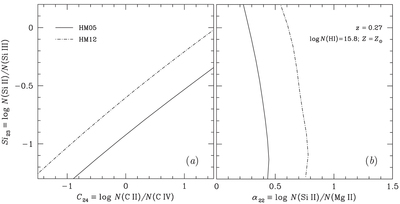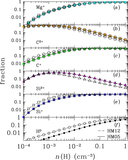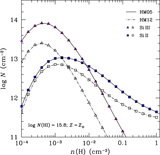Image Details

Caption: Figure 4.
Empirical diagnostics for the spectral slope of the intrinsic ionizing spectrum. The expectation of different relative ionic ratios under different ionizing spectra offers a valuable tool for discriminating between hard and soft ionizing spectra. Adopting the same Cloudy models from Figure 3 and incorporating additional ionic ratios, panel (a) shows that under HM12 the expected ﹩N(\mathrm{Si}\,{\rm{II}})/N(\mathrm{Si}\,{\rm{III}})﹩ ratio is 0.3 dex higher than predictions from HM05 for a fixed ﹩N({\rm{C}}\,{\rm{II}})/N({\rm{C}}\,{\rm{IV}})﹩ ratio. In addition, the relative ﹩N(\mathrm{Si}\,{\rm{II}})/N(\mathrm{Mg}\,{\rm{II}})﹩ ratio is found to be insensitive to the gas density (or the ﹩N(\mathrm{Si}\,{\rm{II}})/N(\mathrm{Si}\,{\rm{III}})﹩ ratio), but depends sensitively on the spectral slope of the ionizing spectrum. The HM12 model predicts a factor of two more Si+ relative to Mg+ than the HM05 model. Combining Si23 with either C24 or ﹩{\alpha }_{22}﹩ therefore places strong constraints for the underlying ionizing radiation field, and thereby reducing uncertainties in gas metallicity estimates.
Copyright and Terms & Conditions
© 2017. The American Astronomical Society. All rights reserved.






